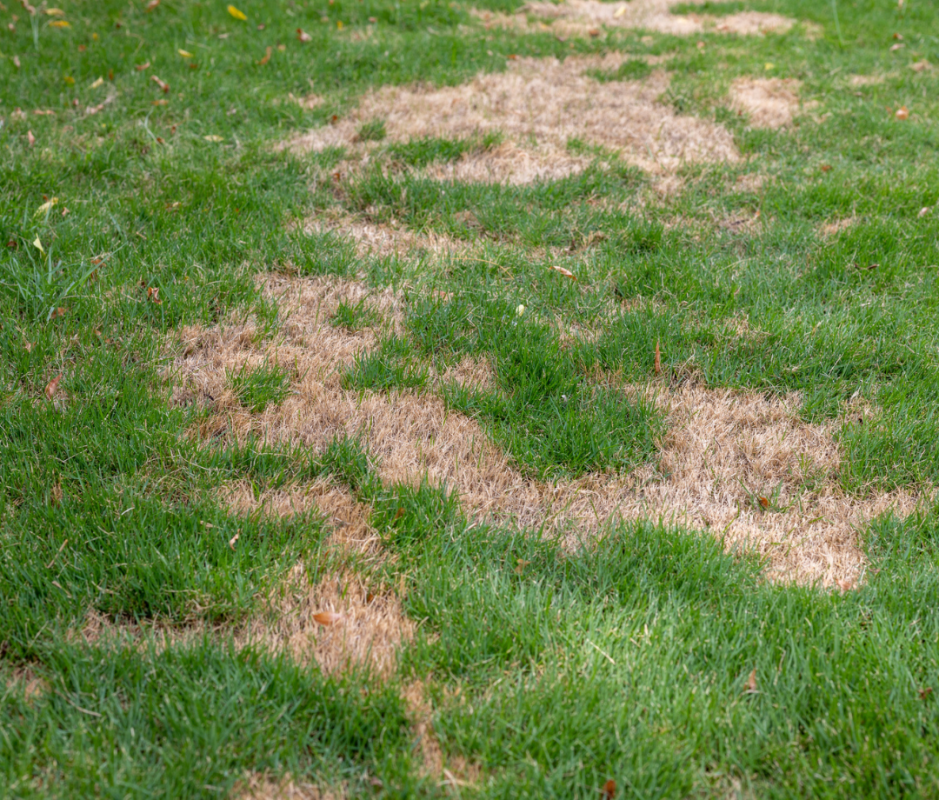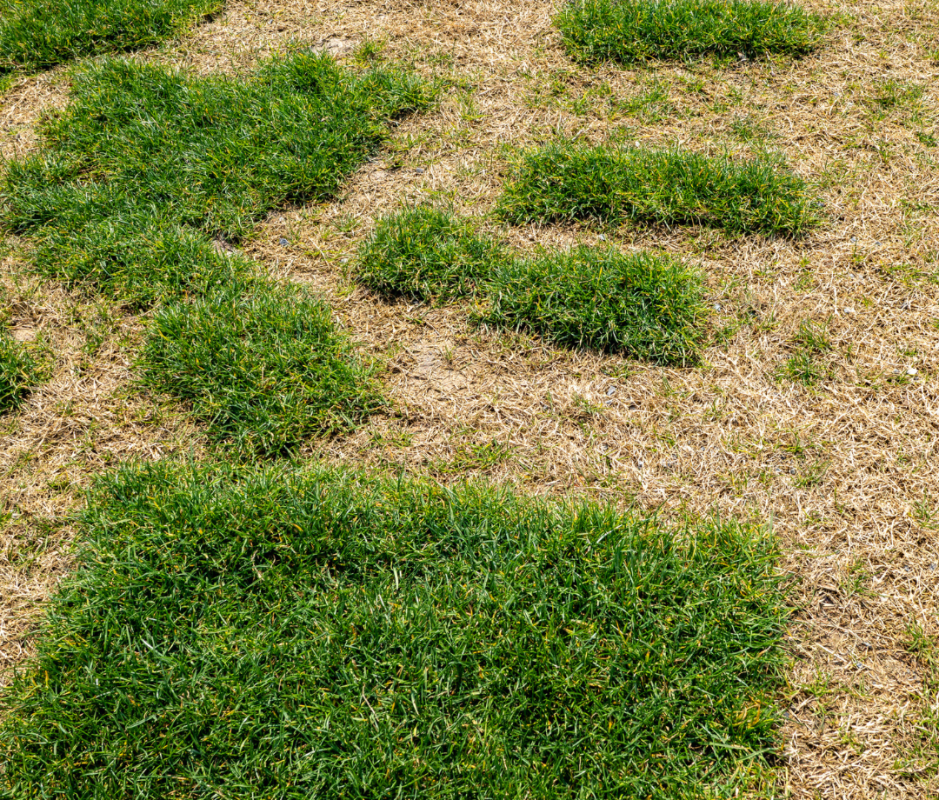Those unsightly patches of brown and yellow forming in your lawn may not be your pet’s fault. They’re more than likely a sign that your yard is suffering from the dreaded lawn fungus. Lawn fungus can start out as small spots or rings, then quickly spread to cover a large swath of your lawn. Don’t despair. By acting fast, you can nip your lawn’s fungus problem in the bud and bring your yard back to a lush green. The first step is identifying which lawn fungus types are plaguing your lawn. Ahead, we list the usual suspects, discuss how to identify them, and cover what lawn fungus treatment you need to apply to get rid of them.
What Is Lawn Fungus?
Per its name, this menace to your yard is a fungal infection that can turn grass blades a variety of colors that are decidedly not green, including red, brown, yellow and even white. It can appear as discolored patches, spots, or rings and come in a variety of forms, from a powdery substance to spots, strands, and even slime. Similar to mold you may find in your house, lawn fungus can also be accompanied by a musty smell.
A variety of factors can cause lawn fungus, including over or under watering, too much fertilizer, warm nighttime temperatures, shade, and rapid temperature changes.
Common Lawn Fungus
The first step to ridding your yard of lawn fungus is identifying the type that you have. Below are some of the most common.
Brown Patch
This common lawn fungus, which is caused by excessive water or too dense a layer of thatch, appears as an irregularly shaped patch of brown, wilted grass with a purple or dark brown border that can range in size from just a few inches in diameter up to several feet. It’s also typically accompanied by wispy growths that resemble cobwebs. Treat with a fungicide designed for this type of fungus, such as propiconazole or pyraclostrobin.
Related: Why Your Grass Is Dying—and Exactly How to Fix It
Fairy Ring
This whimsical sounding fungus is anything but. It appears as a large dark green ring that, according to folklore, is caused by dancing fairies. In reality, it’s caused by fungus that starts in one area that grows outward in a circle. Once mature, the ring may even sprout mushrooms. Fairy rings can be managed by applying a fungicide that contains azoxystrobin or flutolanil but in extreme cases you may need to hire someone to fumigate the lawn.
Dollar Spot
Dollar spot appears as a series of small silver dollar-sized tan-colored spots. If left unattended, these spots can spread and join to create large patches. This fungal disease appears during periods of high humidity when nighttime temperatures are cool and daytime temperatures are hot. Treat by removing the affected grass with a rake and applying a fungicide designed for dollar spot.

Getty Images
Leaf Blight
Leaf blight appears as large patches of straw-colored grass that appear dead. The leaves of grass suffering from this affliction appear shriveled or bleached. Leaf blight usually appears suddenly with large patches of lawn turning brown overnight. Treat with a fungicide that’s effective against leaf blight such as chlorothalonil, mancozeb, and propiconazole.
Gray Leaf Spot
This insidious grass fungus appears as spots on the grass blades that look soft, cotton-like, and grayish from a distance. Larger sections of gray leaf spot will look dirty, scorched, and similar in appearance to drought-affected grass. Rid your grass of gray leaf by applying fungicides such as azoxystrobin (a strobilurin), propiconazole, or chlorothalonil.
Leaf Spot
This fungus appears as light spots with dark brown or purple borders and a yellow background on grass blades. Left to grow, leaf spot will turn large sections of the lawn brown. Treat by mowing the lawn at a higher height and removing excess thatch. If that fails, you can apply a fungicide that contains azoxystrobin, propiconazole, chlorothalonil, or thiophanate-methyl.
Related: Don’t Skip This Late-Summer Fertilizer Step or Your Lawn Will Suffer This Fall
Red Thread
Named for the pinkish thread-like strings that drape over the grass blades, red thread is particularly difficult to prevent as it can appear without warning. From a distance, red thread appears on your lawn as pinkish patches up to a foot in diameter. Mowing and proper fertilization are the first line of defense against red thread. Fungicides that include azoxystrobin, propiconazole, penthiopyrad, and polyoxin are effective for more severe cases.
Slime Mold
This lawn fungus, which is typically found in areas with poor drainage or heavy thatch, can take a variety of forms. It may appear as a slimy yellow patch on the lawn or, when dry, as a gray, black or bluish powdery crust on the grass blades. When dry, slime mold will also release spores into the air if disturbed. Physically remove the mold by scraping it off the grass, then use a fungicide specially designed to treat slime mold.
Melting Out
Grass suffering from melting out looks similar to leaf spot with brown or purplish colored spots that have yellowish centers. As the disease progresses, it turns the entire grass blade brown before rotting. Eventually, it creates large irregularly shaped patches that appear to be melting outward. Use a fungicide that contains azoxystrobin, propiconazole, chlorothalonil, or thiophanate-methyl when melting out first appears.

Getty Images
Necrotic Ring Spot
This fungal disease creates large rings of dead grass typically about a foot in diameter with healthy grass in the middle. The disease affects the grass roots, preventing them from taking in water. Rings can range in size from a foot to several feet in diameter. To treat this disease, aerate the lawn, then apply a fungicide labeled to treat this condition.
Snow Mold
This fungus appears on lawns in areas that experience cold temperatures and heavy snow fall in the winter, thriving in the moist environment created by snow cover. Gray snow mold presents as patches of light brown grass and only impacts the leaves, while pink snow mold is more serious, attacking the roots and crown of the grass. Raking helps break up the grass to allow for air circulation. To prevent snow mold, mow grass short and remove any dead leaves prior to snowfall.
Summer Patch
Appearing in the hot humid months of summer, this fungus appears as large irregular or circular shaped sunken areas of dead grass that are the color of straw. Summer patch occurs where grass receives direct sunlight and is often confused with dollar spot, pythium blight and brown patch. You can identify summer patch by examining the affected grass’ roots, which will be blackened. Treat by applying a fungicide with propiconazole, myclobutanil, triadimefon, tebuconazole, and azoxystrobin.

Getty Images
Rust
Rust forms on the lawn in large patches of reddish brown and yellow and typically appears in the late summer and early fall when temperatures begin to drop and days become shorter. A closer inspection of grass suffering from rust fungus reveals a thin layer of orangish powder on the grass blades. While applying a fertilizer and regular mowing can help, fungicides containing azoxystrobin or propiconazole are also effective.
Yellow Patch
This less serious fungus typically appears in colder months from fall to spring. It appears as reddish brown or yellow patches that range in size from a few inches up to several feet. Yellow patch usually doesn’t do lasting damage to the lawn and typically resolves itself when warmer weather arrives.
Pythium
This fungal disease first appears as small irregular patches that are dark green or appear saturated or slimy. Closer inspection will reveal a white cotton-like growth on the blades. As pythium progresses, the grass may turn brown or yellowish and develop a thicker layer of fungus over matted grass. To treat, rake out the affected area, then apply a fungicide that contains mefenoxam, propamocarb, or cyazofamid.
Related: Lots of Homeowners Let Grass Reseed Itself. Here’s Why That’s a Costly Mistake
How To Prevent Lawn Fungus
Water early and intermittently
Fungus like environments that are constantly wet. Water in the morning, so the lawn will dry out during the day. Instead of frequent waterings, which can keep the soil wet, do two deep waterings per week.
Mow properly
Regularly mow your lawn to the appropriate height for your grass species. Mowing the lawn too short stresses it, making it more susceptible to lawn fungus.
Don’t under- or over-fertilize
Use a slow release fertilizer that provides the just right amount of nutrients to your lawn. Overfertilizing can promote fungus growth while under fertilizing can leave your lawn weak and vulnerable to disease.
Dethatch
Thatch is the layer of organic material that forms between the grass and the soil. A thin layer of thatch helps nourish and protect your lawn. Too thick a layer creates a breeding ground for fungal spores. Monitor the thatch in your lawn and dethatch when it becomes too thick.
Aerate
Aerating allows air to penetrate the soil to help manage moisture, creating a less hospitable environment for fungus while also helping the grass to develop stronger roots that are better able to resist disease.
Test and fix soil
Testing your soil using a soil test kit allows you to see the nutrient imbalances in your soil that make it vulnerable to certain types of fungal diseases. Add the appropriate fertilizer based on your results.
Will lawn fungus go away?
In most cases lawn fungus won’t go away on its own. Once you spot it, it’s crucial to nip it in the bud by immediately treating it. Don’t leave your grass to fend for itself. Lawn fungus can quickly spread over a lawn, making it more difficult to treat.
How can I treat lawn fungus naturally?
If you catch a lawn fungus problem early, you can eliminate it using the following natural methods:
- Adjust your watering practices to prevent excessive moisture that can cause fungus to grow.
- Add balanced fertilizer that makes your grass stronger, so it can better resist fungus.
- Aerate to improve drainage and overseed to build up the turf so it can better resist disease.
When should I hire a professional?
While you can handle smaller lawn fungus problems on your own, if the issue becomes widespread or if your DIY efforts fail, you’ll need to call in a professional. Lawncare professionals have the expertise to more accurately diagnose fungal problems in your lawn, ensuring that they’re treated properly.
